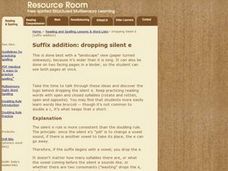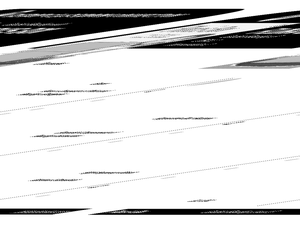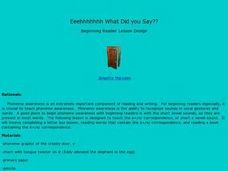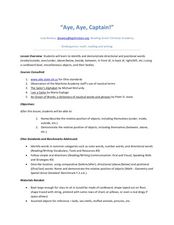Curated OER
Suffix Addition: Dropping Silent "e"
High schoolers engage in a lesson that is concerned with the concept of using the silent "e" in certain words. They practice using the rules while reading them in a review. The application of the rule is given in the lesson and can be...
Curated OER
Guided Reading: Flora's Box
Young readers consider text-to-self connections. Learners discover the text-to-self connection as they read Flora's Box by Tina Althaide. They practice high frequency words, prepositions, and 1:1 correspondence.
Curated OER
Vowel Change of Short E
In this language arts worksheet, students look for the pattern for changing the vowel "E" into the right form for writing the words in the Latin language.
Curated OER
"Whaaa" Said The Baby"
Young scholars recognize phonemes that correspond with the letters in the alphabet. They focus on identifying the short a, /a/ sound. They examine the way their mouths move when making the short a sound mimicking a baby's cry. In given...
Curated OER
Eeehhhhhhh What Did you Say??
Student read pseudo words containing the e=/e/ correspondence and recognize sounds in vocal gestures and words. They explore the e=/e/ correspondence, or short e vowel sound and complete a letter box activity, reading words that contain...
Curated OER
Grandpa Ed
Students engage in an emergent literacy lesson that focuses on phonemic awareness. For practice they become more comfortable with a short vowel phoneme, which can often be the most difficult to identify, by learning it in isolation.
Curated OER
Let's Help the E Out!
Students explore the short /e/ sound. They practice making the sound, noticing how their mouths move to make the sound. They use letterboxes to spell and write 'e' words. They listen for the /e/ sound in a story and then write their own...
Curated OER
Doo-Wop Pop
Doo-Wop Pop, by Roni Schotter is story that focuses on music and performing arts. Language arts activities include phonics, music, writing about dreams, poetry, and writing a letter are included in this literature guide. Furthermore...
Curated OER
Say Aaaaa for Apple
Young scholars say words by blending sounds and phonemes. They decode words in order to read and identify and understand the letter a. This phoneme /a/ is one of the short vowels that are needed to read and write. They will show...
Curated OER
Voicing and Syllable Length (Using Rubber Bands)
Students identify voiced and unvoiced sounds. They practice using short and long vowel sounds. They identify consonants only after paying attention to the length of vowels. They use rubber bands to help them determine the difference...
Curated OER
Iggy and the Icky Sticky Inchworm
Students read and spell words. They have to recognize that letters stand for phonemes and spellings map out spoken words. Long and short vowels are hard to recognize and this lesson focuses on that. The short i is taught in the...
Curated OER
Icky Fingers
Students are introduced to digraphs so they can match letters to their phonemes. They recognize the short vowel i=/i/ in both spoken and written words by practicing reading and spelling words containing /i/. Elkonin Letter Boxes are...
Curated OER
Ellen the Elephant
Students build their sight vocabulary. They study the short vowel correspondence e. They practice pronouncing the /e/ phoneme when shown the grapheme e in written words. They read e = /e/ and write words that contain the e...
Curated OER
Language Arts: Sound Recognition
First graders practice the short i sound by repeating tongue twisters. Later they write the letter i by using the analogy of drawing a straight line from the "fence" down to the "sidewalk" and putting a "basketball" above it. Other...
Curated OER
"Ehhh" I can't hear you!
Students practice writing, sounding out, and identifying words using the short "e" sound. They listen as the teacher reads a tongue twister emphasizing short "e" beginning sounds. The stuents then participate in an activity in which...
Curated OER
Aye, Aye Captain
Learners investigate how correspondences appear differently in different words. They also recognize the difference between long and short vowels. Students study how these correspondences are spelled and pronounced differently.
Curated OER
E-E-E-E-Extra E-E-E-E-Effort
Students listen to a tongue twister emphasizing the short e sound. They practice writing the letter e and attaching different words with that sound to it. They listen to a book about a dog that enhances the letter e. They write a...
Curated OER
The Creaky Door says /e/
Students explore the short /e/ sound, and identify the short /e/ in writing. Students read fun sentences from the board which emphasize the short /e/. They stretch out the /e/ sound every time they come to it while reading. They then...
Curated OER
Open Your Mouth and Say Ahh!
Students identify and hear distinct sounds in spoken and written language. Then they develop a connection between phonemes and their letter symbols which is a key factor in the success of learning how to read and write. Students also...
Curated OER
Hurry Hurry!
First graders identify the fact that groups of phonemes form spoken and written words. They practice working with identifying words that have the letter "h" and point to its position in words.
Curated OER
Ehhh! What'd ya say? Eeeggs
Students identify the vowel sound with a short e. They distinguish this sound /e/ in written and spoken words. Finally, students identify and spell using a letterbox lesson plan and reading various words with the vowel sound and are...
Curated OER
Everyone is Reading
Students study /e/ in both written and spoken words using a tongue twister and letterbox activities. They recite a tongue twisters and make words using letterboxes. Next, they read "Red Gets Fed" and find words that contain the /e/...
Curated OER
Kindergarten Phonics
Students are introduced to the letters and phonemes for C, L, N, P, T, and A. They identify each letter in its upper and lowercase forms. Students differentiate the letters from each other and practice identifying objects and pictures...
Curated OER
Number Recognition Games
Students explore number sense by participating in a math recognition activity. In this number identification lesson, students practice pronouncing names of numbers and matching the number with an amount of objects. Students practice...

























